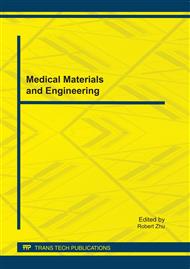[1]
F. T. Wetzel and H. LaRocca, The failed posterior lumbar interbody fusion, Spine (Phila Pa 1976) 16 (1991) 839-845.
DOI: 10.1097/00007632-199107000-00027
Google Scholar
[2]
S. D. Kuslich, G. Danielson, J. D. Dowdle, J. Sherman, B. Fredrickson, H. Yuan and S. L. Griffith, Four-year follow-up results of lumbar spine arthrodesis using the bagby and kuslich lumbar fusion cage, Spine (Phila Pa 1976) 25 (2000) 2656-2662.
DOI: 10.1097/00007632-200010150-00018
Google Scholar
[3]
E. H. Cassinelli, C. Wallach, B. Hanscom, M. Vogt and J. D. Kang, Prospective clinical outcomes of revision fusion surgery in patients with pseudarthrosis after posterior lumbar interbody fusions using stand-alone metallic cages, Spine J. 6 (2006) 428-434.
DOI: 10.1016/j.spinee.2005.11.003
Google Scholar
[4]
G. R. Fogel, J. S. Toohey, A. Neidre and J. W. Brantigan, Outcomes of l1-l2 posterior lumbar interbody fusion with the lumbar i/f cage and the variable screw placement system: Reporting unexpected poor fusion results at l1-l2, Spine J. 6 (2006) 421-427.
DOI: 10.1016/j.spinee.2005.09.011
Google Scholar
[5]
T. R. Oxland and T. Lund, Biomechanics of stand-alone cages and cages in combination with posterior fixation: A literature review, Eur. Spine J. 9 Suppl 1 (2000) S95-101.
DOI: 10.1007/pl00010028
Google Scholar
[6]
J. W. Brantigan, A. Neidre and J. S. Toohey, The lumbar i/f cage for posterior lumbar interbody fusion with the variable screw placement system: 10-year results of a food and drug administration clinical trial, Spine J. 4 (2004) 681-688.
DOI: 10.1016/j.spinee.2004.05.253
Google Scholar
[7]
M. F. Chiang, Z. C. Zhong, C. S. Chen, C. K. Cheng and S. L. Shih, Biomechanical comparison of instrumented posterior lumbar interbody fusion with one or two cages by finite element analysis, Spine (Phila Pa 1976) 31 (2006) E682-689.
DOI: 10.1097/01.brs.0000232714.72699.8e
Google Scholar
[8]
A. Polikeit, S. J. Ferguson, L. P. Nolte and T. E. Orr, Factors influencing stresses in the lumbar spine after the insertion of intervertebral cages: Finite element analysis, Eur. Spine J. 12 (2003) 413-420.
DOI: 10.1007/s00586-002-0505-8
Google Scholar
[9]
K. Goto, N. Tajima, E. Chosa, K. Totoribe, S. Kubo, H. Kuroki and T. Arai, Effects of lumbar spinal fusion on the other lumbar intervertebral levels (three-dimensional finite element analysis), J. Orthop. Sci. 8 (2003) 577-584.
DOI: 10.1007/s00776-003-0675-1
Google Scholar
[10]
C. S. Chen, C. K. Cheng and C. L. Liu, A biomechanical comparison of posterolateral fusion and posterior fusion in the lumbar spine, J. Spinal Disord Tech. 15 (2002) 53-63.
DOI: 10.1097/00024720-200202000-00010
Google Scholar
[11]
T. H. Smit, A. Odgaard and E. Schneider, Structure and function of vertebral trabecular bone, Spine (Phila Pa 1976) 22 (1997) 2823-2833.
DOI: 10.1097/00007632-199712150-00005
Google Scholar
[12]
I. Yamamoto, M. M. Panjabi, T. Crisco and T. Oxland, Three-dimensional movements of the whole lumbar spine and lumbosacral joint, Spine (Phila Pa 1976) 14 (1989) 1256-1260.
DOI: 10.1097/00007632-198911000-00020
Google Scholar
[13]
K. S. Suk, H. M. Lee, N. H. Kim and J. W. Ha, Unilateral versus bilateral pedicle screw fixation in lumbar spinal fusion, Spine (Phila Pa 1976) 25 (2000) 1843-1847.
DOI: 10.1097/00007632-200007150-00017
Google Scholar
[14]
J. Zhao, Y. Hai, N. R. Ordway, C. K. Park and H. A. Yuan, Posterior lumbar interbody fusion using posterolateral placement of a single cylindrical threaded cage, Spine (Phila Pa 1976) 25 (2000) 425-430.
DOI: 10.1097/00007632-200002150-00006
Google Scholar
[15]
J. Zhao, T. Hou, X. Wang and S. Ma, Posterior lumbar interbody fusion using one diagonal fusion cage with transpedicular screw/rod fixation, Eur. Spine J. 12 (2003) 173-177.
DOI: 10.1007/s00586-001-0376-4
Google Scholar
[16]
J. M. Cavanaugh, Y. Lu, C. Chen and S. Kallakuri, Pain generation in lumbar and cervical facet joints, J. Bone Joint Surg. Am. 88 Suppl 2 (2006) 63-67.
DOI: 10.2106/jbjs.e.01411
Google Scholar


